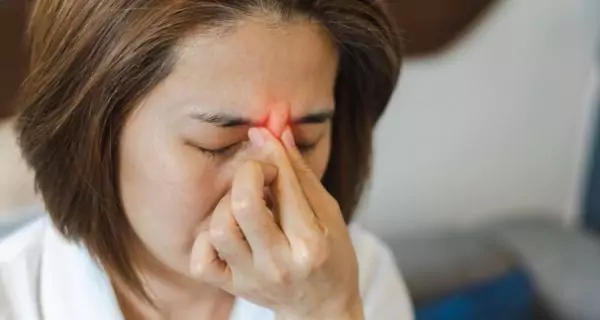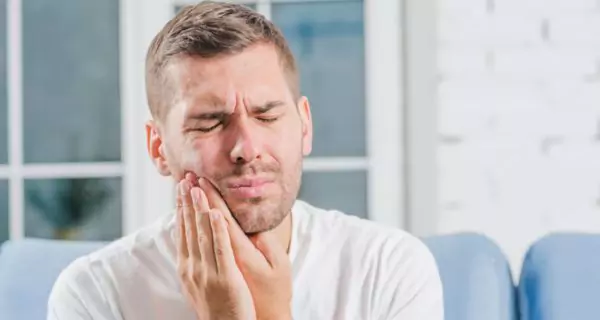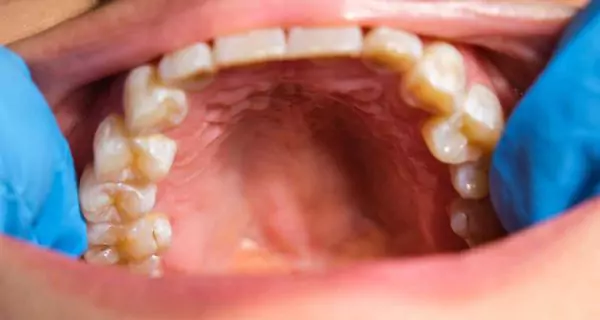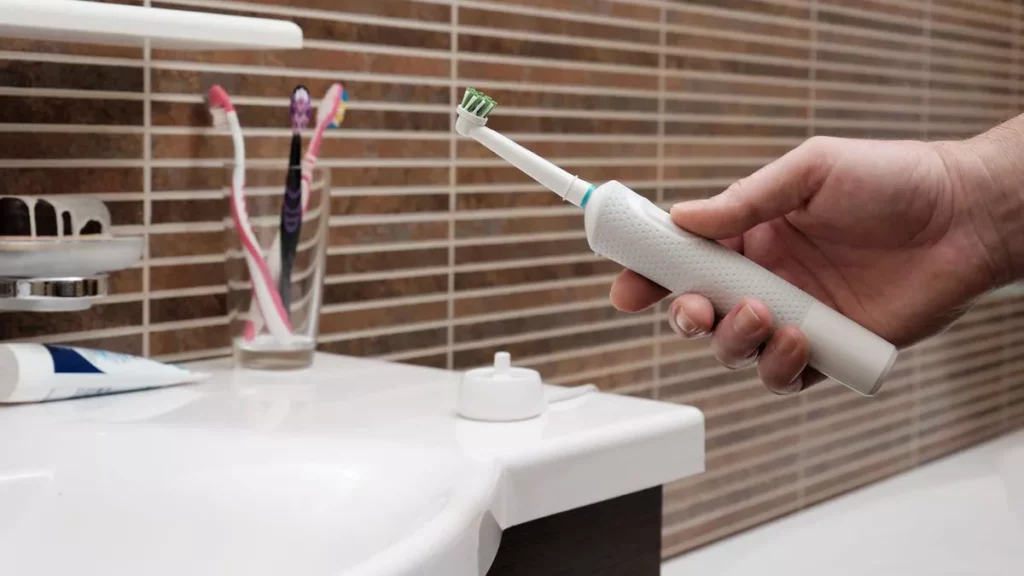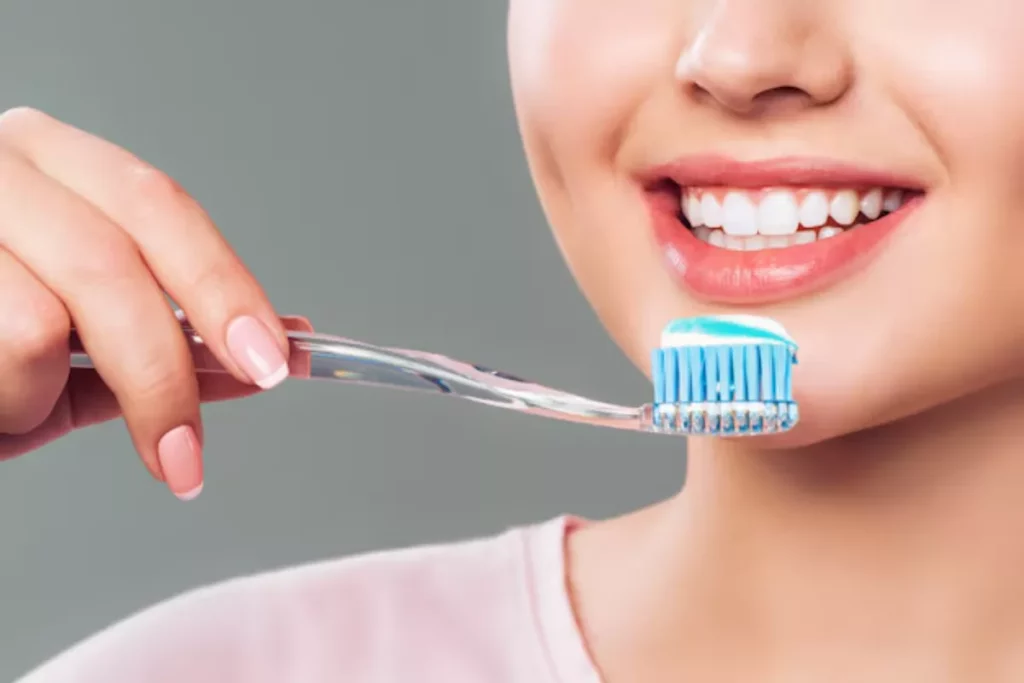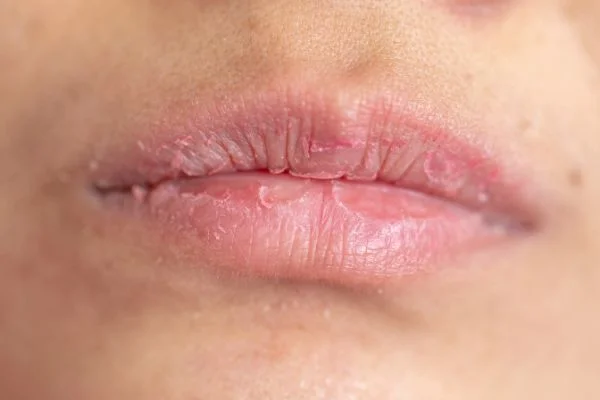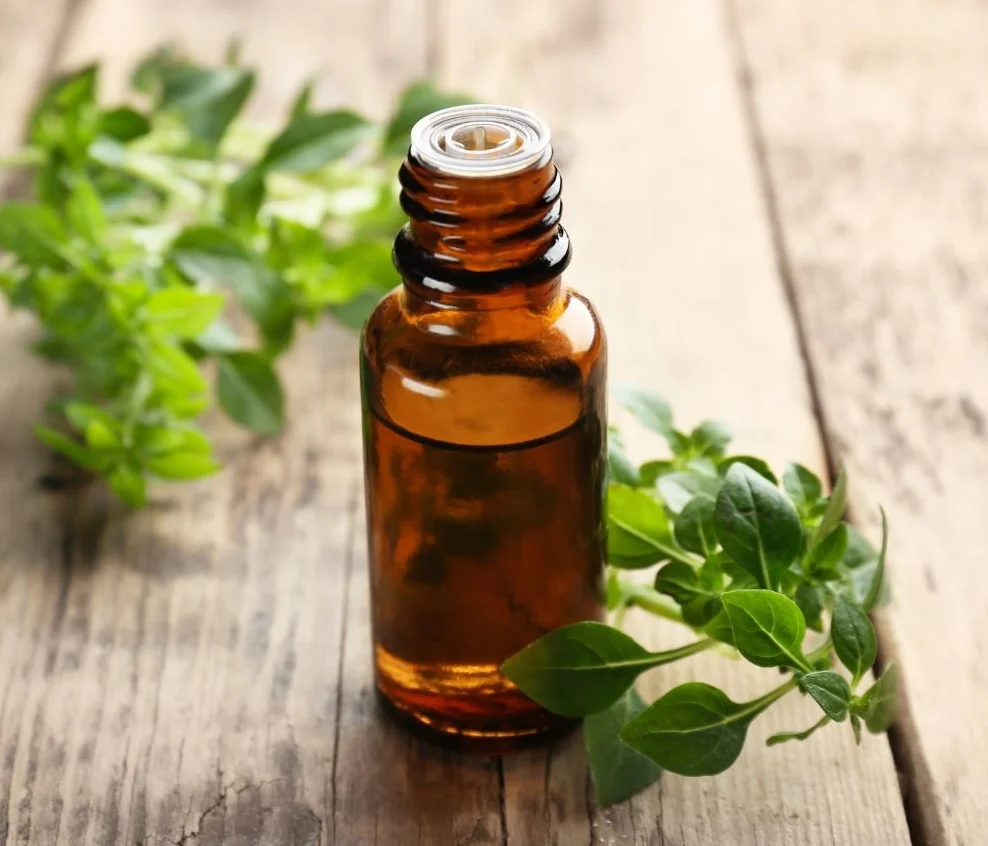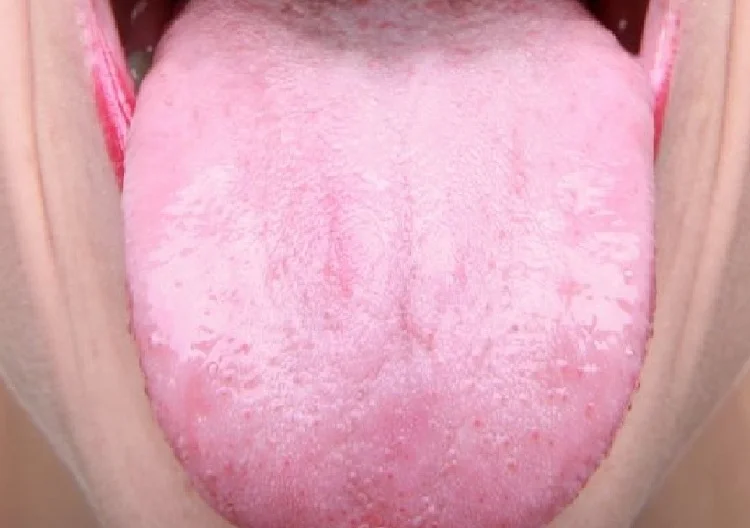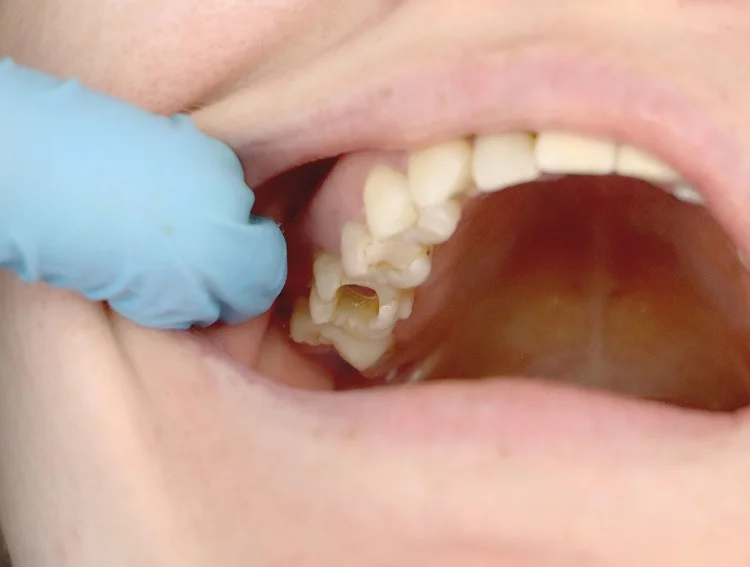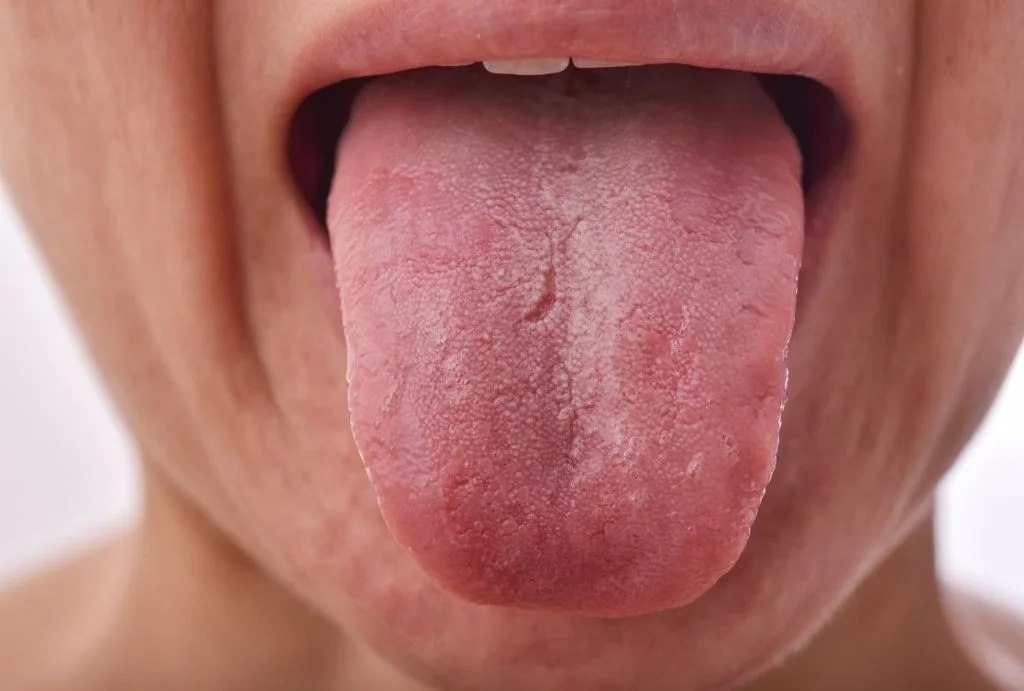Last Updated on: 19th September 2025, 12:29 pm
Pain in the roof of the mouth is serious when it lasts more than a week, is irritating, or comes with swelling, fever, bleeding, or sores that do not heal. These can signal infections, sinus problems, or even oral cancer. If the pain does not improve with home care, you should see a dentist or doctor.
Pain in the roof of your mouth can be annoying – sharp or burning pain makes eating, drinking, or even talking harder. Most of the time, the discomfort is temporary. Pain in the roof of the mouth, however, can mean something more serious.
The roof of the mouth has two parts:
- the hard palate at the front, just behind the teeth
- The soft palate at the back, near the throat and tonsils.
Knowing which area hurts, how long the pain lasts, and any other symptoms that appear will help you know if it’s something simple or if you need professional help.
What causes pain in the roof of the mouth?
Pain in the roof of the mouth has many possible causes. Some are mild and temporary, while others need professional treatment. Knowing the most common triggers will help you understand your symptoms better.
Can hot foods or drinks burn the roof of the mouth?
Yes, burns from hot coffee, tea, or pizza are very common. They may cause:
- sharp pain and redness
- small blisters or swelling
- temporary sensitivity to food and drinks
Minor burns usually heal in a few days, but severe ones may take longer.
Can canker sores develop on the roof of the mouth?
Yes, canker sores (aphthous ulcers) are small but painful. They usually manifest as:
- round, white or yellow spots with a red border
- pain when eating, drinking, or speaking
- discomfort that lasts for 5–10 days
Stress, minor injuries, or immune reactions often trigger them.
Can infections cause pain in the roof of the mouth?
Yes, different infections may affect the palate:
- Viral infections (herpes simplex, coxsackievirus): painful blisters, fever, swollen lymph nodes, fatigue.
- Bacterial infections (like strep throat): redness, swollen tissues, fever, and pain when swallowing.
- Fungal infections (oral thrush/Candida): white creamy patches, burning, itching, soreness; it’s more common in people with diabetes, weak immunity, or inhaler use.
Can sinus problems make the roof of the mouth hurt?
Yes, sinus infections or pressure can cause referred pain. This feels like:
- pressure or heaviness in the upper palate
- pain that seems to spread from the nose or upper teeth
- greater discomfort when bending forward
Can allergies or irritants lead to roof-of-mouth pain?
Yes, the palate is sensitive, and many irritants can cause discomfort:
- acidic foods and drinks (like citrus or soda)
- spicy or very salty foods
- mouthwashes containing alcohol
- poorly fitted braces, dentures, or retainers
These usually cause burning, tingling, or mild soreness.
Do tobacco and alcohol make the pain worse?
Yes, both substances:
- dry out oral tissues
- slow down the healing of burns or sores
- increase irritation and sensitivity
- raise the risk of infections and oral cancer
Can oral cancer cause pain in the roof of the mouth?
Yes, although it is rare. Warning signs include:
- pain or sores that do not heal after 2 weeks
- red or white patches on the palate
- lumps, swelling, or bleeding
- difficulty swallowing
Persistent or unusual symptoms should always be checked by a doctor.
Does the location of pain matter?
Yes, location of the pain can give important clues about the cause. Knowing if the discomfort is in the front, back, one side, or widespread will narrow down possible conditions.
What does pain in the front (hard palate) mean?
Pain in the hard palate is often linked to simple causes, such as:
- burns from hot foods or drinks
- minor injuries from sharp foods (chips, crusty bread)
- canker sores that appear on the hard surface
It is usually mild; home remedies such as saltwater rinses and topical gels are often effective.
What does pain in the back (soft palate or near the tonsils) mean?
Pain in the soft palate or tonsil area is often related to infections or irritation, such as:
- viral infections (herpes, coxsackievirus)
- bacterial infections (strep throat)
- postnasal drip causing inflammation
- allergies leading to swelling or redness
Because these conditions can worsen, it is important to monitor symptoms closely.
What does one-sided pain in the roof of the mouth mean?
Pain that only affects one side may signal a localized problem, like:
- a dental abscess or infected tooth
- a sore or blister forming on one side
- trauma from biting or dental appliances
If you notice swelling, fever, or difficulty swallowing, it’s best to consult a professional.
What does widespread pain in the roof of the mouth mean?
When pain covers most of the palate, it may point to more serious issues, such as:
- systemic infections (affecting the whole body)
- severe oral thrush (fungal infection)
- inflammatory conditions
- early signs of oral cancer
In these cases, warning signs include:
- persistent fever or swollen lymph nodes
- red or white patches in the mouth
- pain lasting more than a week
As a response, immediate medical evaluation is recommended.
What symptoms should you watch for?
Roof-of-mouth pain is often accompanied by other warning signs. These symptoms indicate whether it’s minor or serious.
What visible changes may appear with pain?
- redness or swelling
- white patches or sores
- blisters or ulcers
What general symptoms signal infection?
- fever or chills
- swollen lymph nodes
- fatigue or malaise
What oral problems often occur together with pain?
- dry mouth or bad breath
- tingling or burning sensation
- difficulty speaking or swallowing
These signs help you decide whether home remedies are sufficient or professional care is needed.
How can you relieve pain in the roof of the mouth?
Many cases of roof-of-mouth pain can be eased with simple home remedies and over-the-counter care.
What can you do at home to reduce discomfort?
- Saltwater rinses: Dissolve 1/4 teaspoon salt in warm water. Rinse several times daily to reduce bacteria and soothe tissue.
- Hydration: Drinking enough water keeps oral tissues moist and promotes healing.
- Ice chips or sugar-free lozenges: help soothe burning or tender spots.
- Use a soft-bristle toothbrush: Prevents aggravating sensitive areas.
What foods and habits should you avoid?
- hot or spicy meals
- acidic drinks (soda, citrus juices)
- alcohol and tobacco use
- biting into very hard foods
What over-the-counter products can help?
- Topical numbing gels (e.g., benzocaine, Orajel): provide immediate relief to painful spots.
- Mouth rinses: alcohol-free options like Colgate Peroxyl or TheraBreath help clean and soothe irritated tissues.
- Moisturizing gels, such as Biotène, reduce dryness and protect sensitive tissues.
- Prescription mouthwash: like chlorhexidine, used only if a professional detects infection.
- Gentle oral care tools: soft picks or water flossers clean without irritating the palate.
Regular brushing and gentle flossing prevent infection; thus, having very good oral hygiene is key to helping relieve pain in the roof of the mouth.
Using these products consistently, combined with proper hygiene, can shorten healing time, reduce discomfort, and help the palate recover faster.
When should you see a dentist or doctor?
Most minor causes heal at home, but professional care is needed when symptoms don’t improve.
What are the warning signs that require urgent care?
- pain lasts more than a week
- visible sores do not heal
- difficulty swallowing or speaking develops
- fever, swelling, or lymph node enlargement occurs
- pain is recurrent or worsening
Why is early evaluation important?
- It detects infections before they worsen.
- It prevents complications from untreated conditions.
- It identifies possible oral cancer at an early stage.
Early diagnosis prevents complications, ensures proper treatment, and rules out serious conditions like oral cancer.
When should you worry about pain in the roof of the mouth?
Pain in the roof of the mouth is a common symptom with many possible causes. While most cases are minor, such as burns or canker sores, some may indicate infections or serious issues.
Understanding the location, the symptoms, and possible triggers helps you manage pain effectively. Home remedies, OTC products, and good oral hygiene often provide relief.
Persistent or severe pain should always be checked by a healthcare professional to protect your oral health.
Frequently Asked Questions
Can stress or diet cause pain in the roof of the mouth?
When should I see a dentist or doctor for roof-of-mouth pain?
Is pain in the roof of the mouth a sign of oral cancer?
Can allergies cause pain in the roof of the mouth?
Can smoking or alcohol worsen pain in the roof of the mouth?
Voice and Search (Q&A)
What home remedies help roof-of-mouth pain?
Rinse with warm salt water, stay hydrated, avoid hot or spicy foods, use numbing gels, suck ice chips, and maintain good oral hygiene.
How do I know if roof-of-mouth pain is serious?
Pain is serious if it lasts more than a week, comes with swelling, fever, sores, difficulty swallowing, or keeps returning. See a healthcare professional promptly.
Why does my roof of mouth burn after eating spicy food?
Spicy foods can irritate sensitive oral tissues, especially if you have minor cuts, sores, or inflammation. The burning usually fades within a few hours if the area is not injured.
Share
References
1. Fletcher, J. (2023, July 24). Why is the roof of my mouth swollen? Medical News Today. https://www.medicalnewstoday.com/articles/323028
2. Holland, K. (2023, July 3). Swelling on the roof of your mouth: causes and more. Healthline. https://www.healthline.com/health/roof-of-mouth-swollen
3. Johnson, J. (2024, February 7). What causes a bump on the roof of the mouth? Medical News Today. https://www.medicalnewstoday.com/articles/323063
4. Sardana, K., & Bansal, S. (2014). Palatal ulceration. Clinics in Dermatology, 32(6), 827–838. https://doi.org/10.1016/j.clindermatol.2014.02.023
5. Sattur, A. P., Burde, K. N., Goyal, M., & Naikmasur, V. G. (2010). Unusual cause of palatal pain. Oral Radiology, 27(1), 60–63. https://doi.org/10.1007/s11282-010-0056-3
-
Dr. Yeidy Carolina Mesa [Author]
DDS Yeidy Carolina Mesa Passionate Dentist | Advocate for Accessible Oral Health Education Graduating from Universidad CES in 2022, I am a dedicated general dentist with a lifelong passion for helping others and making a meaningful impact in the world. My journey into dentistry began at the age of 7, inspired by my own experience with braces and overcoming a fear of the dentist. This personal journey shaped my mission to help patients conquer their own dental anxieties and embrace a healthier,...
View all posts
-
Nayibe Cubillos M. [Medical Reviewer]
Pharmaceutical Chemestry |Pharmaceutical Process Management | Pharmaceutical Care | Pharmaceutical Services Audit | Pharmaceutical Services Process Consulting | Content Project Manager | SEO Knowledge | Content Writer | Leadership | Scrum Master
View all posts
A healthcare writer with a solid background in pharmaceutical chemistry and a thorough understanding of Colombian regulatory processes and comprehensive sector management, she has significant experience coordinating and leading multidisciplina...




